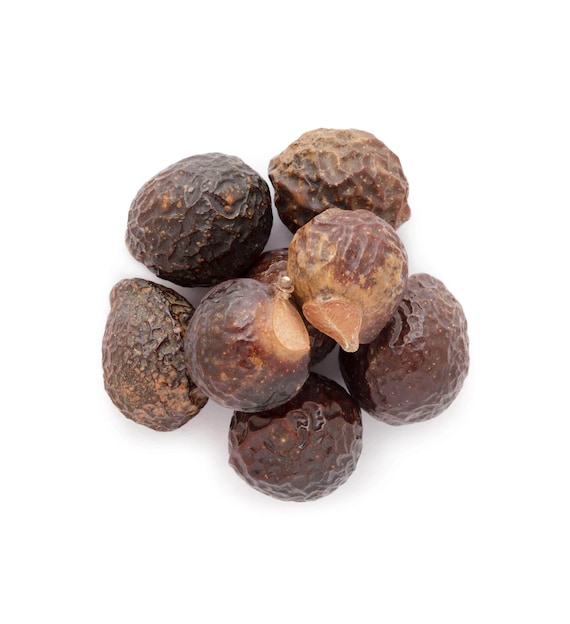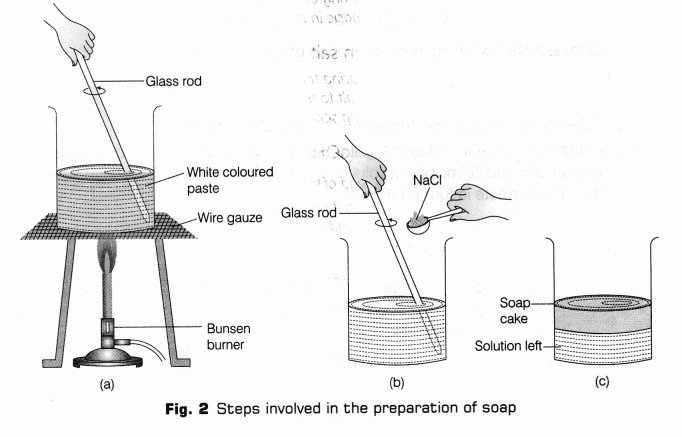Chemicals Used in Cleansing
Subject: Science

Overview
For cleansing, natural products such as wood ash, lemon juice, sajiban, mustard seed cake (Peena), and reetha are utilized. Reetha is a gentle natural soap since it contains saponin. Wood ash is used as an abrasive cleanser and fertilizer, while peena is utilized to strengthen and soften hair. A helpful plant that grows in Nepal, sajiban is utilized for fencing, composting, and healing skin ailments. Lemon juice has a low pH and antimicrobial qualities, making it a potent natural cleanser. Sodium hydroxide, sodium chloride, and vegetable or animal oil are the ingredients used to make soap. Although it is meant to clean clothes, detergent is a hydrocarbon-based chemical that is not biodegradable. In addition to not being biodegradable, detergents can irritate skin, contaminate water and soil, and cause color loss when used repeatedly. They are available in liquid or powder form.
Natural Materials Used in Cleaning
We cleanse using a variety of natural ingredients. The natural ingredients used for cleaning include wood ash, lemon juice, Sajiban, mustard seed cake (Peena), reetha (soapberry), etc.
 |
 |
Reetha (Soapberry)
Reetha contains saponin, which acts as a foaming agent so it can be regarded as a soft natural soap. It has been in use for centuries to clean our bodies and wash clothes. It is a traditional medicinal tree found in Nepal, India, and China. It is generally used to make ayurvedic medicine. The powdered form of its fruit is used in shampoo as a foaming agent.
Peena (Mustard Seed Cake)
Peena (mustard seed cake) has been in use in our country for a long time to wash hair and make it soft and strong. It consists of necessary nutrients for the healthy growth of hair and makes it strong, like folate, niacin, thymine, and vitamin B6, which are forms of vitamin B complex. Its use can control hair fall to a large extent. It also makes hair soft and healthy.
Wood Ash
Wood ash is being used for cleaning purposes. It can be mixed with a small amount of water to form a paste; this paste can then be used as an abrasive cleaner. It can brighten metals and clean dirty utensils.It even removes sticky residue and adhesive. Wood ash is also a good source of potassium, phosphorus, and magnesium for plants, so it can also be used as a fertilizer.
Sajiban
Sajiban is a very useful plant found naturally in different regions of Nepal. It has been used in various ways. Animals do not eat this plant, so it can be used as a fence in our fields. Its leaves are used to make compost manure and its juice is used to cure burns. Similarly, it can be used as an anticancer medicine and its twigs can be used for brushing teeth. It is also a good source of nitrogen, phosphorus, and potash. Therefore, it is also used as an organic fertilizer.
Importance of Sajiban
Cattle can be treated with Sajiban oil and juice to get rid of lice on their bodies. Its oil may also be used to treat infections and illnesses of the skin, as well as to lessen joint and muscle discomfort. Lamps and soaps can also be made with its oil. Teeth can be cleaned with a twig. Glycerin may also be made from its oil. Its seed cake may be used as manure, and its leaves can be used to produce compost. Biodiesel may be produced by refining the acquired oil.
Scientists have described the Nepalese plant Jatropha curcas, sometimes known as Sajiban, as a great source of biodiesel. A sajiban seed typically contains between 30 and 48 percent oil. Three kilos of Sajiban seeds provide around one liter of oil.
Lemon Juice
Citric acid is very concentrated in lemon juice. Its low pH and antibacterial qualities make it a useful natural cleanser. It functions as a natural bleach as well. It smells nice and leaves no residue behind when used to clean objects like wood and clothing. Additionally, it effectively polishes and cleans copper surfaces. For many years, lemon juice has been utilized as medication.
Chemicals Used in Cleansing
Soap
Soap is the term for the long-chain fatty acid salts that contain sodium or potassium. Typically, the ingredients used to make soap are sodium hydroxide, sodium chloride, and animal or vegetable oil. Animal fat or vegetable oil (coconut, olive, or cotton seeds) is boiled with sodium hydroxide and sodium chloride to make soap. Saponification is the process of hydrolyzing vegetable or animal fat with alkali to create soap. Soap is ineffective as a cleanser in hard water because it creates insoluble scum. But since it decomposes naturally, there is no chemical contamination.
Lets learn to Make Soap
Objective: To make soap
The following supplies are needed: vegetable oil or animal fat, sodium hydroxide solution, sodium chloride or edible salt, filter paper, a beaker, and a heat source.
Method/ Procedure
- Fill a beaker with around 40 milliliters of vegetable oil.
- Dissolve 15 grams of sodium hydroxide in 50 milliliters of water to create a 50-milliliter mixture of sodium hydroxide.
- Combine them together, then warm the concoction. It turns into a thick paste after some time spent heating. Add some common salt and a little soda. Soap is helped to separate from the mixture by the salt.

- Next, use a filter paper to filter the mixture. Soap is the residue that remains on the filter paper. Pour the soap into the vessel of your choice now.
- If the soap is left unopened for a day, the desired form will come out of it. Glycerin is present in the filter or residual solution.
Detergent
A chemical called detergent is used to clean clothing. It dissolves more readily than soap. It's a substance made of hydrocarbons that dissolves in water more readily than soap. Another name for it is soapless soap. Like soap, it cleans clothing.Its chemical makeup, however, differs from soap's. It is also suitable for use with hard water. Detergents include things like sodium lauryl sulfate, sodium pyrophosphate, and alkyl benzene sulphonate. It is not biodegradable because it is a chemical. It may therefore result in chemical contamination.
They come in liquid or powder form. In addition, petroleum is used rather than natural oils in the majority of scented soaps available on the market. However, using it may result in issues like burns or irritation of the skin. It also has the potential to contaminate water and soil. After prolonged usage, it can also cause clothing to lose color.
Things to remember
- Natural materials such as wood ash, lemon juice, sajiban, mustard seed cake (Peena), and reetha are used in cleaning for various purposes.
- Reetha contains saponin, making it a soft, natural soap.
- Peena is used to wash hair and make it soft and strong, providing the necessary nutrients for healthy growth.
- Wood ash is used as a paste for cleaning, brightening metals, and cleaning dirty utensils.
- Sajiban is a useful plant found in Nepal, used in various ways, including fencing, composting, treating skin infections, and producing biodiesel.
- Lemon juice is a concentrated form of citric acid with low pH and antibacterial qualities, making it a useful natural cleanser.
- Chemicals used in cleaning include soap, which is made from sodium hydroxide, sodium chloride, and animal or vegetable oil.
- Soap is ineffective in hard water due to its insoluble scum, but decomposes naturally without chemical contamination.
- Detergent is a chemical used to clean clothing, dissolves more readily than soap and is suitable for use with hard water.
© 2021 Saralmind. All Rights Reserved.


 Login with google
Login with google